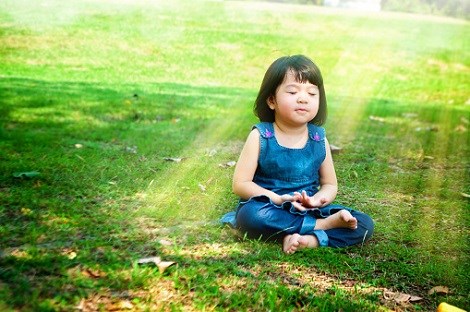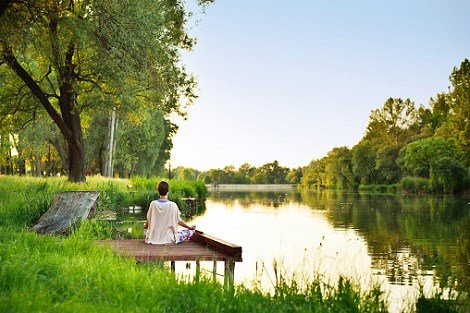10 Mindfulness activities for the classroom

In the most recent issue of English Teaching Professional (Issue 116), in a curious coincidence, both myself and Tanja Jankovič wrote about the topic of mindfulness and the importance for both teachers and students to cultivate mindfulness. One way to do this is to spend some time in the classroom offering mindfulness training.
I come from a family with Buddhist influences and a strong tradition of meditation and Ki-Aikido and growing up, discussions about meditation, Zen Buddhism, Qi/Ki energy were commonplace. In my 20s, I spent several years practising certain meditation techniques that have led to an increased awareness of the importance of mindfulness in daily life.
To add to Tanja’s wonderful list of classroom activities to promote mindfulness amongst her young learners, I’d like to share some of activities that can be both used in and out of the classroom for both adults and children. Each of these activities should take no longer than 5-10 minutes and can bring a sense of calm and focused-awareness to the classroom.
The first five activities are rooted in the traditions of the meditation techniques with a focus on energy flow, while the remaining five are mindfulness techniques to encourage an awareness of one’s senses and their feelings.
Important note: After each of these activities, especially when students eyes are closed, it is important to slowly bring the students back into the room. Do this by telling them to slowly become aware of the sounds around them and the room they are in. Then when they are ready, they can slowly open their eyes.
1. Awareness of the lower Dantian
In Western tradition, the mind is usually associated with the brain or the head, which is in the top-most part of our body. However, some believe that if too much awareness is placed in our heads, balance will be lost. Buddhist and Taoist meditation practices often have their students focusing on the lower Dantian, which is about an inch below the navel. This correlates to the centre of gravity of the human body, and in traditional Chinese medicine and many Chinese martial arts, the Dantian is also seen as the energy centres of the body.
In this activity, have your students sit up straight either on their chairs or cross-legged on the floor. With their eyes closed, guide them to focus on their Dantian. Have them slowly breathe in and then out, noticing how their belly above their Dantian rises and falls. Ask them to imagine that they are a tree and feel how their Dantian roots them to the ground and is a source of immovable strength. Nothing can topple them. This activity can help students centre their thoughts and emotions and lead them to heightened awareness.
2. Awareness of the upper Dantian
The upper Dantian is on the forehead just above and between the eyes and is sometimes known as the third eye. Either sitting up straight on chairs or cross-legged on the floor, have students close their eyes and become aware of their upper Dantian. Placing their awareness on that area on their forehead, encourage students to try and clear their mind of thoughts so that when a thought pops into their head, they gently push it out and not dwell on it. Instead, have them focus on their breathing as you count, “In, two, three, four, out, two, three, four,…”
3. Awareness of the middle Dantian – Holding a space
The middle Dantian is at the level of the heart. Have students sit in pairs facing each other. It would be ideal if they can sit cross-legged in a meditation position with their hands at shoulder-width apart, as if holding a space between them. Then have the students close their eyes and feel the expansion and flow of their middle Dantian, i.e. their heart, into the space they are holding for their partner. Have them imagine that this flow creates a warm resting space for their partner. What does their partner’s energy feel like?

4. Holding a ball
Have students sit in a circle facing the centre. Have them hold their arms out in a circular shape in front of their chest with their fingers loosely touching, as if holding a big ball. Now have students close their eyes and visualize energy flowing in an anti-clockwise direction round in the circle their arms have created. Have them imagine that the energy is like a gush of water in a huge hose, powerful and unstoppable. Have them focused on the power of the energy flowing through their arms.
5. Shrinking and Expanding bodies
Have students close their eyes and feel the boundaries of their body. With their eyes still closed and bodies still, tell them to imagine that their bodies are gradually getting smaller and smaller: smaller than a desk, smaller than a book, smaller than a tennis ball, smaller than a speck of dust… Then tell them that their bodies are now gradually getting bigger and bigger, expanding further and further: bigger than a golf ball, bigger than a cat, bigger than the chair, bigger than the whiteboard, bigger than the classroom, bigger than the tree, bigger than the school building, bigger than the planet earth… This exercise should take about 5 minutes and is great for calming and building awareness of the mind and the body.
6. Music and Mindfulness
Play an instrumental piece of music. Have students close their eyes and listen. What instruments can they hear? What feelings come up within them? What picture can they see in their minds’ eye?
7. Visualise a place
Have students pick a place that they know well. It might be their bedroom, a swimming pool they go to every week, the school library, a yearly holiday destination, etc. Now have students close their eyes and visualize themselves walking around this place slowly. If possible, calmly and slowly talk them through it: e.g. What can you see in front of you? Is there furniture around? What are they made of? What colour are the walls? Reach out and feel them. What texture do they have? Now look down. What is the ground covered with? Is it carpet? Concrete? Soil? What does it feel like to walk on it? What noises can you hear? What’s making those noises? How does it make you feel? What smells are there around? Are they pleasant? Where are the smells coming from? You can easily turn this into a speaking activity by having students describe their experience to a partner after opening their eyes.

8. What is this?
Put students in pairs and have Student A of each pair blindfolded. Student B picks an item from the classroom and puts it in the hands of Student A, who then has to slowly feel the item and describe what they feel: the different textures, the shape, the sharp edges, etc. Student A then has to guess what the item might be.
9. What does this taste like?
In a variation of the above activity, have students each bring in an edible item to the class and display it on a main table. After Student A has been blindfolded, Student B picks one of the items and puts it in Student A’s hands. Student A will put it in their mouth and taste the item. Student A will then be encouraged to become aware of the texture, the taste, the feeling that the item creates in their mouth before chewing it, becoming aware of how that changes the taste, and then finally swallowing it and how that sensation feels. Student A can then guess what the item was. Again, you can turn this into a speaking activity by having Student A describe their experience to Student B after opening their eyes.
10. Mindful walking
For this activity, you need to clear some space in your classroom. Have students walk around the classroom at a slow-to-regular pace. Remind students before the activity to notice the thoughts and emotions that pop into their minds and to make a note of them and push them away. As students walk, ask them to notice what they see and the sensations they feel as they walk.
Regular meditation and mindfulness practice can not only help students learn to manage their emotions and reduce their anxiety, but it can also lead to more confidence, better learning skills, longer attention spans and an ability to be more measured and considered in their judgments and their interactions, life skills that will serve them well beyond the language classroom.



Comments
Write a Comment
Comment Submitted